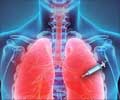A change in the way air pollution is evaluated is on the anvil after scientists at Lund University in Sweden have shown that the tiny particles from traffic fumes are far "stickier" than other smoke and dust particles.
Research leader Jakob Londahl came to this conclusion after measuring how many airborne particles stay behind in the lungs.For that purpose, the researchers used a new device called RESPI, which brings air being inhaled in through one chamber, and exhaled air out through a second chamber.
The device helped the researchers analyse particle number and size in both chambers.
Londahl asked nine healthy adults to breathe into the RESPI device while standing on the kerbside of a six-lane Copenhagen boulevard, which sees around 65,000 vehicles pass by on a typical weekday.
"We found most traffic fume particles to be very small and hydrophobic (having little affinity for water), meaning they did not grow bigger once inside the wet lung. But small particles get deposited in the lung more easily," New Scientist magazine quoted the researcher as saying.
Having noted the street measurements, the researchers compared them with the deposition of particles inhaled from an open fire and a biomass burner, which was measured in a previous study.
Advertisement
According to them, the traffic deposits also had three times the surface area of those inhaled in the biomass combustion study.
Advertisement
The researchers next plan to study how the deposition of traffic exhaust particles differs between healthy people and those with respiratory diseases.
A research article on this study has been published in the journal Environmental Science and Technology.
Source-ANI
THK










